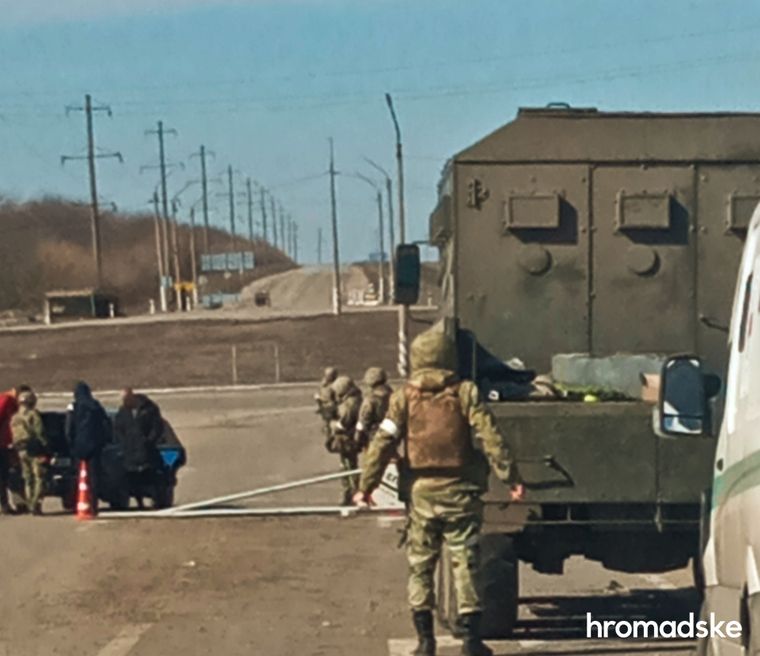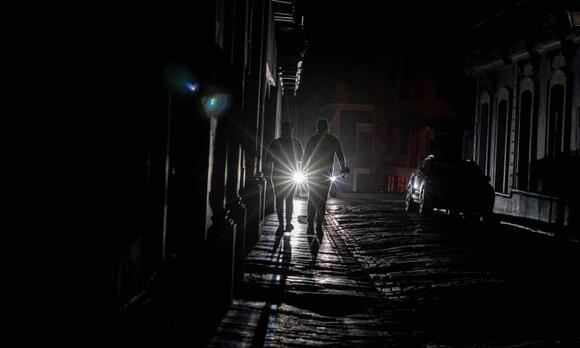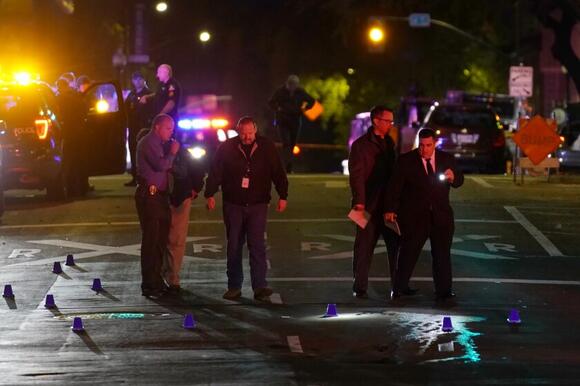Unexploded landmines continue to kill and maim indiscriminately in Syria’s northeast



It’s possible that I shall make an ass of myself. But in that case one can always get out of it with a little dialectic. I have, of course, so worded my proposition as to be right either way (K.Marx, Letter to F.Engels on the Indian Mutiny)
Unexploded landmines continue to kill and maim indiscriminately in Syria’s northeast






NATIONALIZE UTILITIES
Puerto Rico power outage plunges over
1 million into darkness
CANCEL THE DEBT
STATEHOOD OR INDEPENDENCE

More than 1 million customers in Puerto Rico remained without electricity on Thursday after a fire at a main power plant caused the biggest blackout so far this year across the US territory, forcing it to cancel classes and shutter government offices.
The blackout also left some 160,000 customers without water and snarled traffic across the island of 3.2 million people, where the roar of generators and smell of diesel filled the air.
Those who could not afford generators and have medical conditions such as diabetes, which depends on refrigerated insulin, worried about how much longer they would be without power.
Luma, the company that took over transmission and distribution from Puerto Rico’s Electric Power Authority last year, said the blackout could have been caused by a circuit-breaker failure on Wednesday at the Costa Sur generation plant – one of four main plants on the island.
“The system is being restored little by little,” said Kevin Acevedo, a vice-president of Luma, adding that the company is trying to complete the work within 24 hours. “The people of Puerto Rico have to understand that it’s a system with a lot of years. Bringing back Puerto Rico‘s system is a delicate and complicated process.”
Luma said the exact cause of the interruption was unknown. “It’s going to require an exhaustive investigation,” Acevedo said, adding that that the equipment whose failure sparked the fire had been properly maintained.
Officials said at least three generation units were back online by Thursday, with crews working to restore more. The outage occurred two months before the Atlantic hurricane season starts, worrying many about the condition of Puerto Rico’s electrical grid.
“Yes, the system is fragile, no one is denying that, but we’re prepared,” Acevedo said.
Police officers were stationed at main intersections to help direct traffic on Thursday while health officials checked in at hospitals to ensure generators were still running.
The outage further enraged Puerto Ricans already frustrated with an electricity system razed by Hurricane Maria in 2017. Emergency repairs were made at the time, but reconstruction efforts have not yet started, and power company officials blame ageing, ill-maintained infrastructure for the ongoing outages.
A series of strong earthquakes that struck southern Puerto Rico where the Costa Sur plant is located also had damaged it.
The Electric Power Authority also is trying to restructure $9bn worth of public debt to emerge from a lengthy bankruptcy. The company has struggled for decades with corruption, mismanagement and a lack of maintenance.
In June last year, a large fire at a substation in the capital of San Juan left hundreds of thousands without power. Another fire at a power plant in September 2016 sparked an island-wide blackout.
AMERIKA MURDER INC.
Sacramento massacre shows rising dangers of handguns converted into automatic weapons

As state and federal authorities continue to piece together how so many people were killed and wounded in Sunday's shooting in downtown Sacramento, their attention has turned to a small, seemingly innocuous culprit: A gun accessory that quickly and cheaply turns many handguns into weapons capable of spraying dozens of rounds with a single pull of the trigger.
At least one of the guns police say were recovered from the massacre that left six people dead and twice as many injured had been modified with a so-called "auto-sear" or "switch" to boost its firepower. The conversion devices are illegal, and authorities say they are turning up at crime scenes across the U.S. with alarming frequency.
Semiautomatic handguns and rifles require shooters to pull the trigger each time they want to fire a bullet. When retrofitted with a switch, however, these types of weapons become fully automatic and can fire hundreds of rounds per minute, according to Dr. Garen Wintemute, an emergency room doctor at UC-Davis who studies gun use. Switches, which are small cube-shaped attachements that afix to a gun's firing mechanism, can be readily purchased on illicit websites or made with a 3-D printer.
“Basically, what a ... switch does is let you put a machine gun in your pocket or on your belt,” said Wintemute, director the California Firearms Violence Research Center at the university. In a scenario where crowds are present, as in Sacramento, a gun with a switch paired with a magazine that holds a large number of bullets can easily result in greater bloodshed, he said.
The switch devices are classified as machine guns by the Bureau of Alcohol, Tobacco, Firearms and Explosives (ATF), and possessing one is a federal offense. And yet, Wintemute says, instructions for installing one on a gun can be found online and require little to no technical expertise.
The ATF, the federal agency responsible for regulating guns in the U.S., seized about 1,500 weapons modified with switches in 2021, compared to about 300 in 2020, said agency spokeswoman Ginger Colbrun. The sharp jump, Colbrun noted, was part of a longer upward trend in the number of weapons found with switches.
On Wednesday, Sacramento police said that a preliminary investigation suggested at least five shooters may have been involved Sunday in unleashing the fusillade of bullets that struck 18 people, six of them fatally. Amid the carnage along K Street in the shadow of California's Capitol, Sacramento police detectives found a stolen gun that had been “converted to a weapon capable of automatic gunfire." The discovery confirmed suspicions authorities had developed after hearing audio recordings of the shooting on social media that revealed the distinct sound of rounds firing off at rapid speed. Officials estimate at least 100 shots were fired.
Police said in a statement that while they hadn't yet established a motive, "it is increasingly clear that gang violence is at the center of this tragedy."
Handguns retrofitted with switches have surfaced at other California crime scenes. Gunmen used them in the deadly shooting of federal guards in Oakland in 2020, as did gang members in the killing of four people in Fresno the year before.
And in November 2019, members of the Mongolian Boys Society gang sneaked into a backyard party in Fresno and opened fire. Sixteen people were shot and four died in that incident, which was believed to be retaliation for a prior shooting by a rival gang. Fresno police later recovered a handgun used in the shooting that was outfitted with a switch, as well as two ammunition magazines that each held 30 bullets
The power and deadly potential of automatic weapons have set them apart in American's fascination with guns since gangland mobsters wielded Tommy submachine guns in the early decades of the 1900s. Two of those guns killed seven people in the 1929 St. Valentines Day Massacre on Chicago's North Side. Within a few years, the federal government severely restricted access to machine guns or automatic weapons, requiring special permits from the ATF for a person to possess any fully automatic weapon. California law allows ownership of these so-called "dangerous weapons" only with permits.
In November 2021, a federal appeals court upheld the state's ban on gun magazines that hold 10 or more bullets, saying restrictions on their size do not interfere with the right to self-defense.
There are no such restrictions on owning most semiautomatic weapons and Ed Obayashi, a veteran Northern California sheriff deputy and police force expert, said the switches needed to convert them to machine guns can be bought for "as cheap as $10 or $15."
"And while some will tell you a person needs a workshop [to make a switch], the reality these days is someone could learn to do this off YouTube," Obayashi said. "If a guy doesn't know how to put together a jigsaw puzzle, they know someone who can for a price."
Obayashi said the most common switch device in circulation is known as the Glock switch, a device that turns the popular Austrian company's handguns into automatic weapons.
Adding so much firepower onto a weapon not designed for it makes it difficult for people to shoot accurately, increasingly the likelihood that bystanders or other unintended targets could be shot as bullets spray in many directions, experts said.
“It’s kind of like a ‘spray and pray,’” said Det. Pat Hoffman of the Los Angeles Police Department’s gun unit, which is part of a federal gun trafficking task force that in recent years has seized hundreds of the devices at international mail centers. “There’s so many rounds coming out at such a high velocity in such a small amount of time.”
Converter switches, which are often the size of a coin and consist of three parts, are mostly manufactured overseas. Several recent cases shed light on how they come into the possession of criminals.
In 2019, the ATF working with other agencies learned of 4,000 converter switches smuggled into the U.S using deceptive labeling that described them as tools. After intercepting a suspicious package at the Los Angeles International Airport port of entry, investigators eventually tracked down 3,000 of the devices. One of the people who received some of the converters was a Pacoima man, whom LAPD investigators found with five switches and parts of unlicensed rifles inside his home after he accidentally shot himself in 2019.
The switches are predominantly shipped to the region from China, said the LAPD's Hoffman. Customs enforcement officials know the international regions where the devices are made, and how much they weigh, and have gotten “very, very good” at identifying shipments of switches even when the packaging suggests the contents are something entirely different, Hoffman said.
Still, some devices get through screenings, and they also can be built at home using 3-D printers. Hoffman said the LAPD sees them from time to time in the field, but not in large numbers. He did not have exact figures.
Authorities say the devices — which go by many other names including "trigger sears" and “giggle switches” — have grown in popularity amid a rise in “ghost guns,” untraceable firearms that are manufactured or built at home with kits available for sale online. Sometimes, they are attached to guns with ammunition drums or magazines that hold dozens of bullets.
The devices are also gaining popularity among the growing number of white supremacists and far-right extremists who increasingly see the need to arm themselves for what they perceive to be a looming civil war, according to federal prosecutors and court records.
Members of the boogaloo movement, a loose collection of extremists who espouse the violent overthrow of the U.S. government, have used auto sears in shootings and sold them to undercover agents.
Matthew Chen, an alleged member of a local boogaloo affiliate, the Cali Bois, who was indicted in February on illegal weapons charges, allegedly bragged to an undercover FBI agent that he had bought six auto sears and was willing to sell them. Then on Jan. 20, Chen met with the undercover FBI agent in a Pomona park parking lot and sold him an auto sear for $250, according to an affidavit. Chen invited the agent to his Pomona apartment, where he showed a video of him shooting fully automatic weapons in the desert.
This story originally appeared in Los Angeles Times .